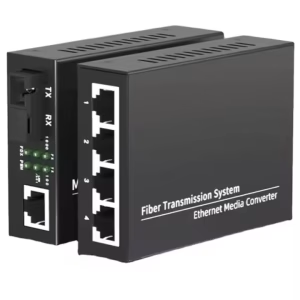
Fiber Optic Media Converters: Bridging Networks for Seamless Connectivity
Introduction
In today’s high-speed digital landscape, businesses and organizations rely on robust network infrastructure to maintain seamless communication. However, many networks still use a mix of copper (Ethernet) and fiber optic cabling, creating compatibility challenges. This is where fiber optic media converters come in—they serve as the essential bridge between different network media types, ensuring smooth data transmission across varied infrastructures.
In this blog post, we’ll explore:
What fiber optic media converters are and how they work
Key types and their applications
Benefits of using media converters
How to choose the right converter for your needs
What Is a Fiber Optic Media Converter?
A fiber optic media converter is a networking device that converts electrical signals from copper Ethernet cables (RJ45) into optical signals for fiber optic cables (and vice versa). This enables seamless integration between different network segments, extending reach and improving performance.
Key Features:
Copper-to-Fiber Conversion – Connects traditional Ethernet devices to fiber networks.
Extended Distance Support – Fiber can transmit data over much longer distances than copper.
Noise & EMI Immunity – Fiber is immune to electromagnetic interference, making it ideal for industrial environments.
Scalability – Easily upgrades legacy copper networks to high-speed fiber.
Types of Fiber Optic Media Converters
1. Gigabit Media Converters
- Supports 10/100/1000 Mbps speeds.
- Ideal for enterprise networks, CCTV systems, and small data links.
2. 10G Media Converters
- Delivers 10 Gigabit Ethernet speeds.
- Used in data centers, ISPs, and high-bandwidth applications.
3. Industrial Media Converters
- Rugged, hardened design for harsh environments (extreme temps, vibrations).
- Commonly used in manufacturing, oil & gas, and transportation.
4. PoE Media Converters
- Supports Power over Ethernet (PoE) + fiber conversion.
- Perfect for IP cameras, wireless access points, and IoT devices.
5. Managed vs. Unmanaged Converters
- Unmanaged: Plug-and-play, no configuration needed.
- Managed: Offers advanced features like VLAN, QoS, and remote monitoring.
Why Use a Fiber Optic Media Converter?
Extends Network Distance – Fiber can run kilometers vs. copper’s 100m limit.
Future-Proofs Networks – Easily upgrades copper links to fiber without replacing entire infrastructure.
Improves Security – Fiber is much harder to tap than copper.
Reduces Latency – Ideal for high-speed trading, VoIP, and video streaming.
Industrial Durability – Withstands extreme conditions where copper fails.
Common Applications
- Enterprise Networks – Connecting office floors with fiber backbones.
- Data Centers – Extending server connections beyond copper limits.
- Smart Cities – Linking traffic cameras, sensors, and control systems.
- Industrial Automation – Reliable communication in factories and plants.
- Telecom & ISPs – Delivering high-speed internet to end-users.
How to Choose the Right Media Converter?
- Speed Requirements – 1G, 10G, or higher?
- Fiber Type – Single-mode (long-distance) or multimode (short-distance)?
- Environment – Standard, industrial, or outdoor use?
- PoE Support – Needed for cameras or wireless devices?
- Managed Features – Do you need remote monitoring?
Conclusion
Fiber optic media converters are the unsung heroes of modern networking, enabling seamless integration between copper and fiber infrastructures. Whether you need Gigabit, 10G, industrial-grade, or PoE-enabled solutions, choosing the right converter ensures optimal performance and future scalability.
